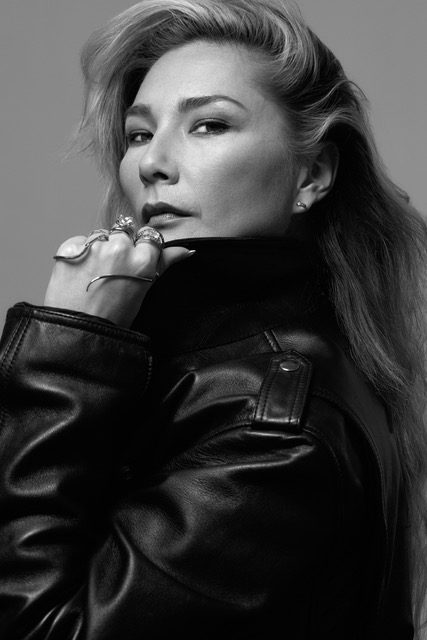
JCK editor-in-chief Victoria Gomelsky and news director Rob Bates interview two guests—Vikki Tobak author of Ice Cold: A Hip-Hop Jewelry History, and Jules Kim, owner and designer of Bijules Jewelry. Both women discuss how they came up in the New York City club scene, and how it influenced both of their careers. Vikki talks about the early days of hip-hop and how its connection to jewelry began and evolved. Jules notes some jewelry styles that have their origins in African and African American culture, and the beauty of their evolution through time.
Listen Now
Show Notes
02:30 The hosts introduce their guests, Vikki Tobak and Jules Kim
03:05 Vikki shares her background and interest in jewelry and hip-hop
07:40 Jules goes into her background
15:20 Vikki talks about why the hip-hop world got interested in jewelry
19:00 Jules describes grill culture and how it evolved from humble origins
23:45 Vikki’s favorite quotes and moments from her book
Episode Credits
Hosts: Rob Bates and Victoria Gomelsky
Guests: Vikki Tobak, Jules Kim
Producer and engineer: Natalie Chomet
Plugs: @jckmagazine, Bijules, Ice Cold: A Hip-Hop Jewelry History
Show Recap

The Intersection of Hip-Hop and Jewelry
Vikki is a longtime journalist and curator. Both of the books she has written so far have been focused on hip-hop. She was an immigrant kid in Detroit, rooted in a city that was founded on music culture. She fell in love with hip-hop as a kid in the ’90s, and moved to New York City during an immersive time of music and club culture. She started out working for a record label at age 19, then started writing about this culture.
The book has a different angle on the culture, following a through line that’s been a constant during Vikki’s life. When asked when she started researching this topic, she says, “Informally? Since my mom bought me a Nefertiti pendant when I was living in Detroit in the 1980s.” Formally, she started in the beginning of the pandemic. It was challenging at that time because she couldn’t visit the Diamond District or Canal Street, as she would have wanted to do in person. She says that jewelry is part of the fabric of hip-hop and club culture, and you see it reflected in what people are wearing when you walk down the streets of New York.
Musical Influences
Many musicians contributed to Vikki’s book. Slick Rick—known as the don of hip-hop jewelry—wrote the foreword; LL Cool J wrote an essay about a trip he took to Côte d’Ivoire in 1988 and the African link to hip-hop jewelry; and there’s also a contribution from A$AP Ferg, the first hip-hop ambassador for Tiffany. The common thread across these stories is the shared value of success and what we wear on our bodies representing so much more—status, “making it,” being royalty. Jewelry is more than conspicuous consumption. It’s a communication.

All About Jules
Jules grew up in Richmond, Va. As soon as she and her twin sister could, they moved to New York City. They were both deejaying and throwing parties. Jules came to the city as a fashion intern and was fascinated with nightlife and the fast-paced, shared communal experience. Jules thinks of jewelry as a “forever material,” which meant something at a time when everything was fleeting. She assisted other fashion designers by day, and carted vinyl records to parties across town by night. She recognized that this experience didn’t last forever, and she eventually decided she wanted to make something that lasts.
She started Bijules in 2002. She wore all her pieces out and sold them at clubs. She was influenced by street fashion and decided to implement the nameplate with graffiti. When asked if she had any training, Jules said no. She went to university on a flute scholarship. She realized formal training wasn’t for her. She studied fashion in France, then came back and took a jewelry 101 class. It inspired her to dedicate herself to learning.
Downtown Culture
Vikki talks about the jewelry scene on Canal Street compared to the Diamond District. The Canal Street scene was cheaper, more playful. The Diamond District was an older world. Hip-hop and club culture is a culture of hustle, which overlaps with jewelry industry. Both are made up of immigrants. Vikki describes a “motley crew” that had similar hustle, dreams, and aspirations.
Hip-Hop and Jewelry Then
Vikki talks about the origins of hip-hop’s interest in jewelry. The young people who were to become the superstars of the genre looked to the street for their styles. The first instance of jewelry on a hip-hop album cover was Kurtis Blow’s debut album in 1980, and those chains were very tiny and layered with a few pendants. As hip-hop stepped into its power in the ‘90s and more money started coming into the culture, early styles started coming along. That moment quickly led to artists using platinum, diamonds, and other precious materials in their jewelry. Trends included label pendants—the Roc-A-Fella chain, Death Row pendant, etc. There were many milestones that inform how the jewelry looks and the influence it has on the larger jewelry world.
Grill Culture
Vikki says hip-hop style often has ties to African culture, which can be seen in Fulani hoop earrings, Ashanti rings, Tuareg rings, etc.
Jules says the grill originally came from a need for dental attention. She describes how she partnered with Eryka Badu on a project called Badrool, where Jules’ husband took photographs in Senegal. One photo showed a ritual connected to jewelry—a type of grill. The badrool looks like rose gold falling out of Badu’s mouth.
Hip-Hop and Jewelry Now
When asked if she has any favorite parts of her book to note, Vikki references a Biggie Smalls quote, “You never thought that hip-hop would take it this far.” Now everyone is dying to work with hip-hop artists. She thinks of this quote and remembers the early days when that was not the case. Jules shares a positive connection someone made as a result of Vikki’s book—it speaks to the culture and how it’s committed to communicating style through jewelry. Jules’ anecdote shows how the book is actively inspiring new designers.
- Subscribe to the JCK News Daily
- Subscribe to the JCK Special Report
- Follow JCK on Instagram: @jckmagazine
- Follow JCK on X: @jckmagazine
- Follow JCK on Facebook: @jckmagazine







